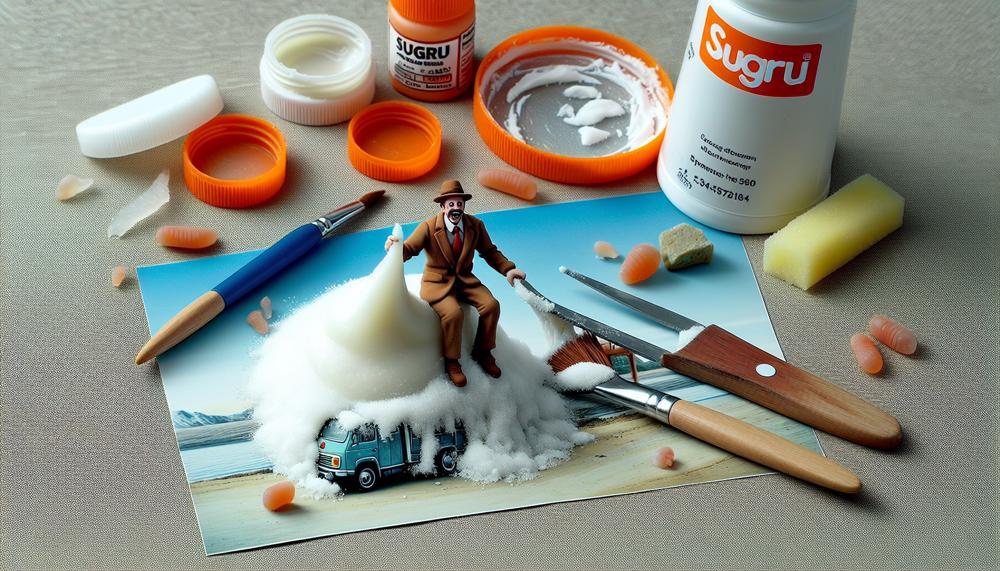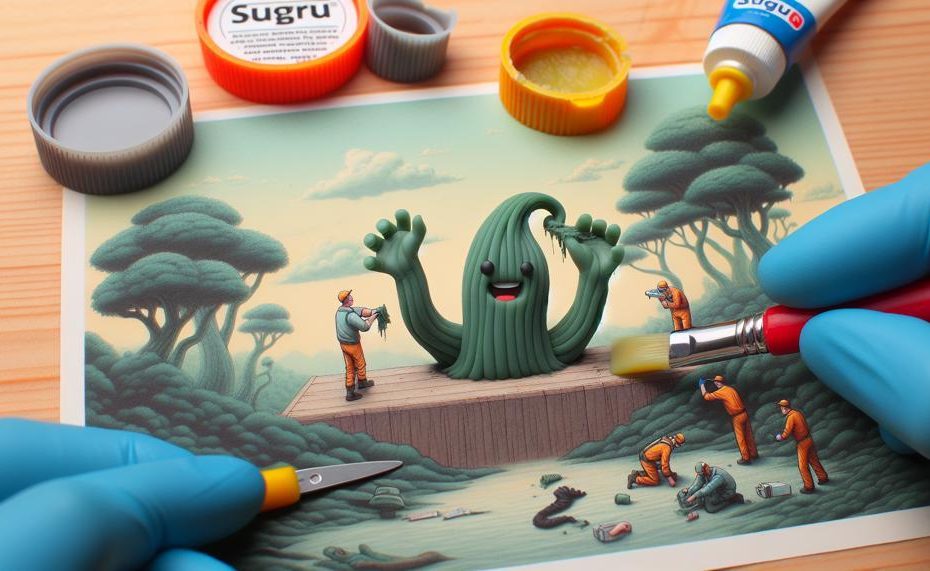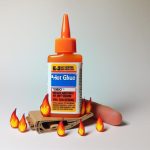Are you tired of staring at that unsightly, cracked phone case? Or perhaps you regret using sugru to customize your favorite mug and now it’s stuck forever. We’ve all been there.
While sugru is a fantastic product for fixing and personalizing items, it can sometimes be too permanent. But fear not, removing sugru is easier than you may think.
In this blog post, we’ll guide you through the process of safely removing sugru from various surfaces without causing any damage. Say goodbye to those unwanted sugru mistakes with our simple steps:
- Understanding the properties of sugru
- Essential tools for removal
- Step-by-step instructions for removing sugru from different surfaces
- Tips to prevent future mishaps with sugru
- Alternative methods for stubborn sugru removal
So, let’s get started.
Table of Contents
Definition Of Sugru
Sugru is a unique and versatile adhesive that has a wide range of uses, from repairing objects to creating new ones. It is made of silicone and transforms into a strong and flexible rubber when it dries, making it ideal for filling gaps in awkward spaces, working with unusual shapes, and creating permanent bonds with various materials. In comparison to other adhesives like mouldable plastic, epoxies, and super glue, Sugru offers more flexibility and creativity.
Using Sugru as an adhesive is a straightforward process. Simply roll it into a small sausage shape and press it onto the smaller object when bonding two things together. The powerful adhesive properties of Sugru will ensure a secure and long-lasting bond. However, it should be noted that Sugru does not adhere well to certain surfaces such as metal, wood, non-porous surfaces, and liquids.
While Sugru is known for its strength and durability, it can also be easily removed with the right tools and techniques. For plastic surfaces, using a hairdryer on low heat or boiling water can help loosen the adhesive. If there is any dried residue, a vacuum cleaner, solvent such as acetone or alcohol, steel wool brush, or toothpick can be used to remove it. For helmets, degreasers like WD-40 or Goo Gone are effective in removing Sugru.
How To Remove Sugru – What Supplies Are Needed
When it comes to removing sugru, having the right supplies is crucial to ensure a safe and effective process. In addition to the heat source and isopropyl alcohol, it is also recommended to have a cleaning cloth, plastic scraper, gloves, protective eyewear, and a razor blade on hand. These supplies will help prepare you for any scenario that may arise during the removal process.
For specific removal situations, it may be beneficial to have additional supplies on hand such as a toothbrush, acetone, soft cloth, and degreasers like WD-40 or Goo Gone. Having a variety of supplies available is important because the removal process can vary depending on the surface and amount of sugru present.
In addition to these supplies, it is also essential to have proper ventilation when working with sugru and its removal process. The fumes from alcohol and other solvents can be strong, and having a well-ventilated area and proper ventilation equipment will help prevent any potential health hazards.
In some instances, using a vacuum cleaner, steel wool brush, or toothpick may also come in handy for removing dried sugru residue from surfaces. These tools can be useful for getting into hard-to-reach areas or for more stubborn residue.
Overall, having the right supplies and following proper techniques is key to successfully removing sugru without causing damage to the underlying surface.
Mechanical Removal
Mechanical removal is a safe and efficient method for getting rid of Sugru from various surfaces.
This technique involves physically removing the adhesive without using any chemical solutions. Here are the steps to follow for mechanically removing Sugru from different surfaces:
Gather the necessary tools
Before starting, make sure you have all the required tools, such as a plastic scraper, heat source, gloves, and protective eyewear.
These tools will help you remove Sugru safely without causing damage to the underlying surface.
Apply heat to soften the adhesive
Using a heat source like a hairdryer or heat gun, warm up the dried Sugru for 10-15 seconds.
This will soften the glue, making it easier to remove.
Peel off the softened Sugru
After applying heat, use a plastic scraper to gently peel off the softened Sugru from the surface.
Be careful not to apply too much pressure as it can damage the underlying material.
Use a flat-edged tool
If peeling alone does not work, you can also use a flat-edged tool, like a credit card or old gift card, to scrape off any remaining Sugru. Again, be gentle and avoid scratching or damaging the surface.
Clean the surface
Once all the Sugru has been removed, use a cleaning cloth and isopropyl alcohol to wipe off any residue or stickiness from the surface.
Repeat if necessary
If there are still traces of Sugru left on the surface, you can repeat the process of applying heat and peeling until it is completely removed.
| Surface Type | Recommended Tools | Additional Tips |
| Hard Surfaces (e.g., wood, metal) | Plastic scraper, heat source | – Use a razor blade for tougher spots – Apply heat for longer periods if needed |
| Plastic Surfaces | Flat-edged tool, heat source | – Be extra gentle to avoid scratching the surface – Use a toothbrush and degreaser for tougher areas |
| Fabric or Clothing | Gloves, heat source, protective eyewear | – Use a hairdryer on low heat to prevent fabric damage – Pre-treat with stain remover before washing |
| Glass or Ceramic Surfaces | Plastic scraper, heat source, isopropyl alcohol | – Test isopropyl alcohol on a small area first – Avoid using sharp tools that can scratch the surface |
Chemical Solvents
Chemical solvents, like acetone, isopropyl alcohol, mineral spirits, white vinegar, and Goo Gone, are well-known for their ability to remove sugru from various surfaces.
These powerful solvents work by breaking down the adhesive bonds, making it easier to remove the dried glue. However, it’s crucial to keep in mind that these solvents can also cause damage to certain surfaces.
Therefore, it’s always recommended to test them on a small area first before using them on a larger surface.
Additionally, it’s important to carefully read and follow the instructions and safety precautions provided by the manufacturer when using any chemical solvent.
Using chemical solvents can be a tricky process, especially when trying to remove dried glue. One of the most popular options is Goo Gone, which is specifically formulated to break down even the toughest adhesive bonds. This makes it an excellent choice for removing sugru from surfaces.
However, the effectiveness of Goo Gone can vary depending on the type of surface it is being used on. For example, it may work well on plastic surfaces but may not be as effective on metal or wood.
When using Goo Gone to remove sugru from surfaces, it’s important to follow the proper steps to ensure maximum effectiveness.
First, spray Goo Gone directly onto the affected area and let it sit for 15-30 minutes. This will allow the solvent to break down as much of the dried glue as possible.
Then, use a damp paper towel to wipe away the liquid and any remaining sugru.

If there is still some residue left behind, repeat the process until the surface is completely clean.
Heat Application
Heat application is a highly effective technique for removing sugru from various surfaces.
By using heat, you can make the sugru pliable and easier to remove. This can be achieved by applying heat from a hairdryer or heat gun at a safe distance from the surface.
The ideal temperature for this process is between 60-70°C (140-158°F). Below is a table summarizing the steps for using heat to remove sugru.
| Step | Description |
| 1 | Prepare the surface: Before applying heat, ensure that the surface is clean and free of any debris or loose sugru. |
| 2 | Apply heat: Use a hairdryer or heat gun to blow hot air at a safe distance from the surface. Move the heat source around to evenly distribute the heat. |
| 3 | Test for pliability: After a few minutes of heating, test the sugru’s malleability by gently touching it with a plastic card or cloth. If it feels soft and pliable, move on to the next step. |
| 4 | Remove the sugru: Using a plastic card or cloth, gently scrape or rub off the softened sugru from the surface. Repeat the heating process if necessary until all of the sugru is removed. |
| 5 | Clean the surface: Once all of the sugru is removed, use a mild soap and water solution to clean any remaining residue from the surface. |
It’s important to note that heat may not be suitable for all surfaces, so it’s best to test on a small, inconspicuous area first. Additionally, avoid using excessive heat or heating the sugru for too long as it can cause damage to the surface.
Ultrasonic Cleaning
Ultrasonic cleaning is a highly efficient method that utilizes high-frequency sound waves to produce tiny bubbles that vigorously shake and loosen dirt, debris, and sticky substances such as sugru from various surfaces.
These bubbles are formed through a process called cavitation, where the constant positive and negative pressure waves generated by the sound waves cause them to rapidly implode, releasing a burst of energy that effectively dislodges and breaks down sugru particles. This process is incredibly effective in reaching even the tiniest crevices and corners of an object, making it the perfect solution for removing sugru.
What’s more, ultrasonic cleaning is not only fast, but it is also environmentally friendly as it uses biodegradable cleaning solutions. Ultrasonic cleaning is a revolutionary technique that harnesses the power of sound to eliminate even the most stubborn substances like sugru from surfaces.
Through the process of cavitation, which involves the creation and implosion of microscopic bubbles, ultrasonic cleaning effectively loosens and breaks down sugru particles with unparalleled precision. In fact, this method is so effective that it can reach even the smallest and most intricate areas of an object, ensuring a thorough clean.
And unlike other methods, ultrasonic cleaning doesn’t harm the environment as it uses biodegradable cleaning solutions.
Sanding Or Grinding
When it comes to removing sugru, there are two main methods that can be used: sanding and grinding.
These methods may seem similar, but they have distinct differences in their approaches, capabilities, and outcomes.
| Method | Description | Effectiveness for Removing Sugru |
| Sanding | Uses abrasive materials or sandpaper to create a rough surface and eliminate impurities. | Highly effective for removing sugru, especially on delicate surfaces such as wood or plastic. |
| Grinding | Utilizes a rotating abrasive wheel or disc to refine surfaces or remove imperfections. | Can be effective for removing sugru on tougher surfaces like metal. |
Sanding is a more versatile method as it can be applied to various surfaces, including wood, plastic, and glass. It is also suitable for eliminating harsh impurities and creating a rough surface for coatings or paints.
On the other hand, grinding is typically used on metals like aluminum, stainless steel, and titanium. It is best for refining surface finishes or sharpening edges.
Both sanding and grinding require safety precautions to be followed due to the production of dust and potential health hazards. Proper protective gear should always be worn when using these methods.
Ultimately, the choice between sanding or grinding when removing sugru depends on the desired end result and the unique properties of the material being worked on.
If the goal is to create a rough surface for coating or paint, sanding may be the better option. However, if the sugru is on a tougher surface like metal, grinding may be more effective.
Using An Adhesive Remover
The process of removing sugru using an adhesive remover is simple yet effective, requiring a few key steps for success.
These include gathering the necessary materials, applying the adhesive remover, waiting for it to work its magic, wiping away the sugru, and cleaning the surface afterwards. Let’s take a deeper look at each step and its importance.
- Gather materials: The first crucial step in removing sugru using an adhesive remover is to gather all the necessary materials. These include an adhesive remover specifically designed for silicone-based adhesives, a cloth or paper towels, and a plastic scraper or old credit card.
- Apply the adhesive remover: Once you have all your materials ready, apply the adhesive remover onto the surface with the sugru. The amount needed will depend on the size and thickness of the sugru. Be sure to follow the instructions on the adhesive remover carefully for safe and effective use.
- Wait for it to work: After applying the adhesive remover, give it time to penetrate the sugru. This will help break down the adhesive and make removal easier. Depending on the strength of the adhesive remover, this may take 5-10 minutes.
- Wipe away the sugru: Once the adhesive has had time to work, use a cloth or paper towel to wipe away as much of the sugru as possible. For thicker layers, a plastic scraper or old credit card can be helpful in gently scraping away the softened material. Just be careful not to damage the surface underneath while scraping.
- Repeat if necessary: If there are any remaining bits of sugru, repeat the process of applying adhesive remover and wiping away until the surface is clean. It may take multiple rounds of this process to completely remove all traces of sugru.
- Clean the surface: After successfully removing all traces of sugru, it’s important to thoroughly clean the surface with soap and water to remove any residue from the adhesive remover. This ensures that the surface is completely clean and ready for its next use.
By following these steps, you can confidently and effectively remove sugru using an adhesive remover. Always remember to read and follow the instructions on the adhesive remover for safe and effective use.
Professional Removal Services
| Advantages | Description |
| Efficiency | Professional removal services have the necessary resources and experience to quickly and efficiently remove sugru, saving you time and effort. |
| Safety | Handling heavy or bulky items during removal can be dangerous, but professionals are trained and equipped to do so safely. |
| Proper Disposal | By hiring a reliable service, you can ensure that sugru is disposed of properly and responsibly, avoiding any legal issues. |
| Environmental Responsibility | Professional removal services are committed to reducing their impact on the environment by recycling or donating unwanted items whenever possible. |
| Improves Space and Aesthetics | Removing sugru and other unwanted items from your space can improve its overall look and feel, making it more comfortable and aesthetically pleasing. |
| Flexibility and Convenience | Professional services offer flexibility in terms of one-time or recurring removal needs, making it easy to keep your space clutter-free. They also provide convenient solutions for your removal needs. |
| Excellent Customer Support | These companies provide excellent customer support, ensuring a smooth and stress-free experience for their clients. Their friendly and helpful staff will assist you throughout the process. |
| Economic Benefits | Hiring local professional removal services not only benefits you but also supports the local economy by creating jobs and contributing to community growth. By choosing a local company, you are investing in your community’s economic growth. |
Professional removal services have several advantages over attempting to remove sugru on your own. These companies have the necessary resources, experience, and expertise to quickly and efficiently get rid of sugru and other unwanted items. They are trained and equipped to handle heavy or bulky items safely, reducing the risk of injury or damage to your property.
Proper disposal is essential when removing sugru, as improper disposal can lead to legal issues. Professional removal services ensure that sugru is disposed of properly and responsibly, avoiding any potential problems.
They are also committed to reducing their environmental impact by recycling or donating items whenever possible.
In addition to these benefits, hiring a professional service can also save you time, money, and effort. Instead of dealing with sugru removal yourself, you can leave it to the experts and focus on other tasks.
Removing unwanted items from your space can also improve its overall look and feel, making it more comfortable and aesthetically pleasing.
Aftercare And Maintenance
Aftercare and maintenance for surfaces or objects repaired with sugru are crucial for maintaining its durability and longevity. Understanding the properties of sugru is key to ensuring proper care. It is essential to follow instructions carefully and handle the repaired area with gentleness.
Additionally, it is important to avoid exposing sugru to extreme temperatures.
When cleaning, be sure to do so gently to avoid damaging the repair. Regularly checking for wear and tear is also recommended to catch any potential issues early on.
By following these simple yet effective tips, you can ensure that your repairs with sugru will stand the test of time and remain in top condition. Proper maintenance not only extends the life of your repair but also saves you time and money in the long run.
Proper Maintenance
Understanding the properties of sugru is the first step in proper maintenance. This unique material is designed to bond to a variety of surfaces, making it a versatile solution for many repairs. Its adhesive properties are activated by pressure, so be sure to apply enough force when using it.
Additionally, sugru is resistant to water, heat, and cold, making it suitable for both indoor and outdoor use.
Following instructions is crucial for achieving the best results with sugru. Be sure to read the packaging carefully before using it. This will ensure that you are using the correct amount and applying it correctly. Once applied, allow it to cure for 24 hours before using or exposing it to any stress.
When handling surfaces or objects repaired with sugru, be gentle to avoid damaging the repair. Avoid exposing it to extreme temperatures as this can affect its adhesive properties. If you need to clean the repair, use a mild soap and water solution and avoid using harsh chemicals.
Also Read: How Long Does Sugru Take To Set?
Conclusion
In conclusion, sugru is a powerful adhesive that offers endless possibilities for repairs and creations. However, if you find yourself in need of removing it from a surface, don’t panic. With the right tools and techniques, it can be easily removed without causing any damage.
To start off, it’s crucial to understand the properties of sugru and have the essential tools on hand for removal. These include a heat source, plastic scraper, gloves, protective eyewear, and isopropyl alcohol.
By carefully following our step-by-step instructions for removing sugru from different surfaces such as plastic, fabric/clothing, glass/ceramic, and even skin/hair, you can safely and effectively say goodbye to this adhesive.
Furthermore, we’ve included helpful tips to prevent future mishaps with sugru and alternative methods for stubborn removal.
From using chemical solvents like Goo Gone to applying heat or ultrasonic cleaning techniques, always remember to test on a small area first and proceed with caution when removing sugru.






